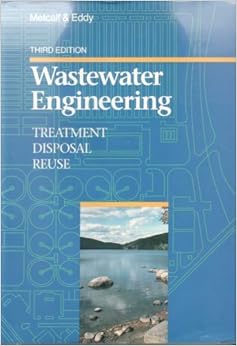
Free Downloads Wastewater Engineering: Treatment Disposal Reuse

like new

Hardcover: 1334 pages
Publisher: McGraw-Hill; F 3rd Edition edition (1991)
Language: English
ISBN-10: 0070416907
ISBN-13: 978-0070416901
Product Dimensions: 2.2 x 7 x 9.8 inches
Shipping Weight: 4.1 pounds
Average Customer Review: 3.9 out of 5 stars See all reviews (9 customer reviews)
Best Sellers Rank: #324,701 in Books (See Top 100 in Books) #49 in Books > Engineering & Transportation > Engineering > Civil & Environmental > Environmental > Waste Management #1160 in Books > Engineering & Transportation > Engineering > Mechanical

I first got exposed to the textbook as an undergraduate student in civil engineering. Served as an excellent in depth textbook for that level. During my masters program it was a good starting point. As a consulting engineer, I can find most of the basic and fundamental answers. The language is lucid and simple. I have read lots of books on wastewater engineering. Agreed that there are more detailed texts available on specific areas of wastewater treatment, but this textbook does a very good job of striking that balance just right of covering material in enough detail for students and the practising engineer. It is usually enough unless you are writing a masters thesis or a doctoral dissertation. This text, together with the companion textbook, Collection and Pumping of Wastewater has served me very well during my college and professional career. Highly recommended to anyone looking for a good book on wastewater treatment. I very respectfully disagree with the gentleman from Istanbul above who feels that this book is poor. When taking my PE exam, if I was to be limited to just one textbook on wastewater, I would take this one.
The book gives the modern process engineer enough background to engineer complete waste water treatment plants. Specially the biological part is very good. Only at the physical chemical part, the information is based on installations produced in the US. The European (nicer) designes and developments are not described in the book.
there is a bit of truth in all the above reviews. It has not entirely been my bible, but more a Readers Digest version; if I need a quick answer, it is the first book I grab. Yes there are a lot of mathematical mistakes or misprints in it,and that includes a good number of the worked examples, which rather defeats the purpose. Yes it is very American orientated, but it also has tables and footnotes throughout, giving useful or immediate conversions to other systems, well, metric that is, not imperial. There are a lot nicer processes about, some definitely European. But that misses the point a bit: the most fundamental problem is that the book is nearly ten years old. Therefore it is not surprising that newer processes are missing. I am desperately looking forward to a fourth edition, and I'll be the first to buy it! In the meantime I'll keep using the third. But what happened to the (Indian) paperback version, which was a lot better priced for a book of this age? Still, there is no substitute!
This book was of great necessity on the PE exam and I wouldn't have been able to do much without it. A definite must for your bookshelf.
This book contains large amount of information and therefore it may be argued that it is an important reference in the field. Unfortunately, as a textbook for undergraduate teaching, it is terrible. There are several mistakes in the solved examples. Problems at the end of each chapter are not well prepared. Solving the problems at the end of a chapter do not necessarily contribute to a better understanding of the material contained in that chapter.A large number of equations related to the activated sludge process are presented, but they are not well connected. How these equations can be systematically used in design is neither well explained nor well exemplified. Overall, this book is not suitable for self-study without the guidance of an experienced instructor/engineer who also has practical experience in wastewater plant design and operation.Then again, there are very few good books in this field (if any). The field of water and wastewater treatment certainly needs good authors/teachers!
Wastewater Engineering: Treatment Disposal Reuse Wastewater Engineering: Treatment and Reuse Spellman's Standard Handbook for Wastewater Operators: Fundamentals, Volume I (Spellman's Standard Handbook for Wastewater Operators Series) Wastewater Engineering: Treatment and Resource Recovery Fundamentals of Wastewater Treatment and Engineering Software Reuse and Reverse Engineering in Practice (Unicom Applied Information Technology) Wastewater Treatment Plant Operations Made Easy: A Practical Guide for Licensure Biological Wastewater Treatment, Second Edition, Revised and Expanded (Lecture Notes in Pure and Applied Mathematics) Operation of Municipal Wastewater Treatment Plants (3-Volume Set) Industrial Wastewater Treatment: A Guidebook Handbook of Water and Wastewater Treatment Technologies Design and Retrofit of Wastewater Treatment Plants for Biological Nutritient Removal, Volume V Handbook of Water and Wastewater Treatment Plant Operations Challenges in Fine Coal Processing, Dewatering, and Disposal Tank Waste Retrieval, Processing, and On-site Disposal at Three Department of Energy Sites: Final Report Prudent Practices for Disposal of Chemicals from Laboratories Waste Disposal in Academic Institutions Hazardous Laboratory Chemicals Disposal Guide, Second Edition Nuclear Reactions: The Politics of Opening a Radioactive Waste Disposal Site Upcycling: 33 Ways To Reuse Old Glass Jars, Mason Jars, & Wine Bottles For Home Decorations & Much More!



